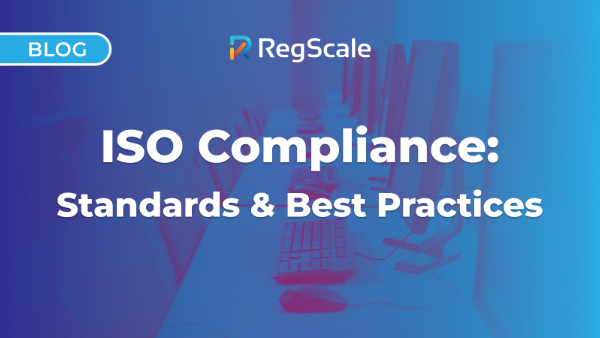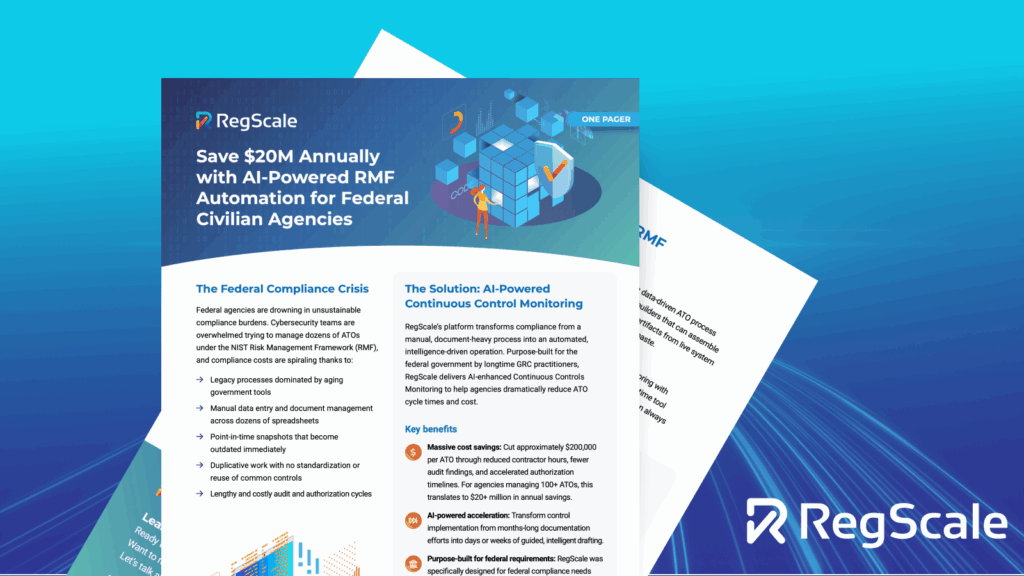
The business landscape is more competitive than ever, and organizations are constantly seeking ways to demonstrate their commitment to quality, security, and operational excellence.
Enter ISO compliance: a compliance framework that not only helps businesses streamline their operations but also builds trust with customers, partners, and stakeholders worldwide.
Whether you’re a startup looking to establish credibility or an enterprise aiming to optimize your existing processes, understanding ISO standards can be a game-changer for your organization. From quality management systems to cybersecurity frameworks, ISO compliance offers a roadmap to better business practices that can significantly impact your bottom line.
But what exactly is ISO compliance, and why should it matter to your business? Let’s dive in and explore how these international standards can transform your operations.
What is ISO compliance?
ISO compliance is adherence to standards developed by the International Organization for Standardization (ISO), a global network of national standards bodies that creates internationally recognized guidelines for different industries and business functions.
Think of ISO standards not as a single regulation but rather as a set of universal blueprints for excellence. These comprehensive frameworks provide organizations with proven methodologies to manage everything from quality control to information security, environmental impact, and workplace safety.
What makes ISO compliance particularly valuable is its focus on systematic approaches rather than one-time fixes. The emphasis is always on creating sustainable, repeatable processes that drive long-term success. And when a company achieves ISO compliance, it demonstrates that its processes meet internationally accepted benchmarks for performance and reliability.
The journey to becoming ISO compliant typically involves a detailed certification process. First, organizations must thoroughly understand the specific ISO requirements that apply to their industry and operations. This might include implementing quality management systems (QMS) under ISO 9001, establishing an information security management system (ISMS) for ISO 27001 compliance, or developing environmental management systems aligned with ISO 14001.
Then, companies will undergo rigorous evaluation by an accredited certification body. These independent organizations perform comprehensive ISO audits and documentation reviews, examining everything from risk management protocols to continuous improvement mechanisms.
The beauty of ISO compliance lies in its flexibility. Organizations can pursue single certifications or implement multiple standards simultaneously, creating a comprehensive framework that addresses various aspects of their business operations.
Why is ISO compliance important?
ISO compliance has become essential for modern businesses looking to build trust, manage risk, and stay competitive. The benefits go well beyond having certificates on display, creating real business value for companies across industries.
Enhanced credibility and customer satisfaction: When customers and stakeholders see ISO certification, it immediately signals reliability and professionalism. ISO compliant organizations often become preferred vendors because the certification demonstrates a genuine commitment to quality.
Improved risk management and business continuity: ISO standards provide proven frameworks for identifying and mitigating threats before they become costly problems — which in turn helps organizations proactively manage disruptions from supply chain issues, data breaches, regulatory changes, and more.
Cost savings through efficiency: While certification requires upfront investment, ISO compliant companies typically see long-term savings from the streamlined workflows and optimized processes that naturally emerge.
Competitive advantage through operational excellence: Lastly, ISO’s emphasis on continuous improvement, internal audits, and corrective action creates a culture of excellence that permeates business operations. This systematic approach to quality and efficiency can become a sustainable competitive advantage that’s difficult for competitors to replicate.
Core ISO Standards and Their Applications
With over 25,000 ISO standards in existence today, there’s no way to cover them all in detail. However, some standards are much more relevant and well-known than others. Below are five of the most common ISO standards used worldwide.
ISO 9001: Quality Management Systems
One of the most widely adopted ISO standards globally, ISO 9001 focuses heavily on customer satisfaction, process improvement, and consistent delivery of products or services. It requires organizations to develop clear operating procedures, establish measurable quality objectives, and create feedback loops that turn customer insights into actionable improvements.
Many companies find that ISO 9001 compliance naturally streamlines their workflows and reduces waste, leading to both improved quality and lower operational costs. Key components include regular internal audits to identify non-conformities, corrective action procedures, and documentation systems that ensure knowledge stays within the organization.
ISO/IEC 27001: Information Security Management Systems (ISMS)
ISO 27001 uses comprehensive risk assessment and security controls to help organizations protect sensitive information from data breaches and vulnerabilities. The standard requires thorough risk assessments that consider everything from employee access controls to third-party providers. Businesses pursuing ISO/IEC 27001 certification must demonstrate they can identify information assets, assess security risks, and implement appropriate controls.
ISO 14001: Environmental Management
This environmental management system standard takes a lifecycle approach, encouraging organizations to consider environmental factors throughout their operations. Companies implementing ISO 14001 typically see improvements in resource efficiency, waste reduction, and energy consumption. The focus on systematic environmental management rather than one-time green initiatives may even reveal cost-saving opportunities like energy efficiency improvements or waste stream optimization.
ISO 45001: Occupational Health and Safety
Governing occupational health and safety management systems, ISO 45001 requires organizations to proactively identify hazards before incidents occur. The standard emphasizes worker participation in safety management, recognizing that frontline employees often have the best insights into potential hazards and practical solutions.
Beyond protecting employees, ISO 45001 helps organizations avoid significant costs associated with workplace incidents, including workers’ comp claims, regulatory fines, and operational disruptions.
ISO 13485: Medical Device Standards
ISO 13485 establishes quality management requirements for the medical device lifecycle, covering everything from initial design through manufacturing, distribution, and post-market surveillance. ISO 13485 compliance also serves as a foundation for meeting other regulatory requirements (e.g. FDA regulations). Many medical device companies find that certification streamlines their path to global market access.
Maintaining ISO Compliance
Although achieving ISO certification is important, it’s just the beginning. Maintaining compliance requires ongoing commitment and systematic management. The good news is that ISO standards are designed to create self-sustaining systems that actually get easier to manage over time.
The foundation of maintaining ISO compliance lies in regular internal audits and continuous monitoring. Most organizations schedule these internal audits quarterly or semi-annually, depending on the complexity of their operations and risk profile. From there, they can review their operating procedures, assess whether their security controls are functioning as intended, and identify any non-conformities that need corrective action.
The job of maintaining compliance effectively is made increasingly easier with automation. Many organizations are already using compliance management software with automated features to streamline documentation, track corrective actions, optimize workflows, and monitor key performance indicators. When disruptions occur — whether from supply chain issues, personnel changes, or external threats — automated systems can also help ensure that compliance efforts continue uninterrupted.
The key to sustainable ISO compliance is embedding it into your organization’s culture and teaching employees how their daily work contributes to quality outcomes, information security, or environmental goals. Regular training, clear communication about the benefits of compliance, and recognition of team members who champion continuous improvement can all contribute to long-term success.
Measuring success: the ROI of ISO compliance
It’s easy to view ISO compliance as a cost center. After all, certification costs valuable time and staff resources — and that’s not to mention the time spent on internal audits and policy reviews.
However, the most successful companies will approach ISO compliance by tracking metrics that demonstrate a clear return on investment. The key is identifying the right indicators and establishing baseline measurements before implementation begins.
Financial metrics often provide the most compelling evidence of ISO compliance value. Organizations typically track reductions in operational costs through improved efficiency, decreased waste, and fewer non-conformities. For ISO 27001, companies monitor the costs avoided through prevented data breaches and improved cybersecurity posture. Meanwhile, environmental management systems under ISO 14001 often show measurable savings in things like energy consumption and waste disposal costs.
Operational metrics can also reveal how ISO compliance improves day-to-day business performance. These might include faster resolution times for customer issues, reduced time-to-market for new products, or improved employee safety records.
Finally, some businesses track stakeholder confidence indicators, like customer retention rates, partner satisfaction scores, and the ability to win new business based on ISO certification status. Regardless of your specific metrics, creating a comprehensive dashboard can be a great way of showing how compliance investments translate into better organizational performance and tangible business outcomes.
Easier ISO Compliance with RegScale
Managing ISO compliance manually? You’re likely struggling with unnecessary complexity, tedious paperwork, and information siloes. But it doesn’t have to be that way.
RegScale’s Continuous Controls Monitoring platform transforms how organizations approach ISO compliance. By centralizing documentation, offering AI-assisted workflows, and providing real-time visibility into compliance status, our platform slashes manual work and cuts down on time and cost.
Interested in optimizing your ISO compliance? Learn how RegScale can help.
Ready to get started?
Choose the path that is right for you!
Skip the line
My organization doesn’t have GRC tools yet and I am ready to start automating my compliance with continuous monitoring pipelines now.
Supercharge
My organization already has legacy compliance software, but I want to automate many of the manual processes that feed it.
